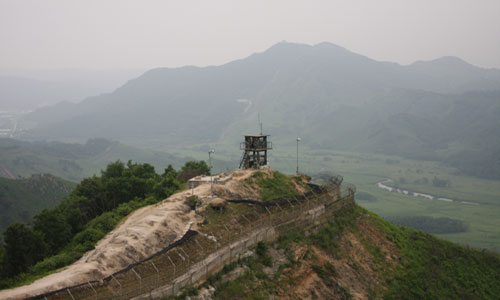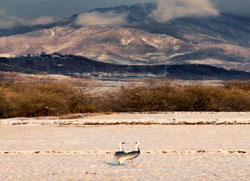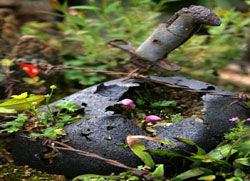
As painful the memory is, there is just no place like it. The demilitarized zone, or DMZ, has almost always been the number one spot that tourists (especially from the west) want to visit. In what is a sad reminder of a country divided into halves, time has all but stopped in this place, leaving only wild plants and animals to thrive. That's how the place has earned its new name for the 21st century: “Peace and Life Zone” or PLZ.
The government is fully supportive of the idea. Last year the Korea Tourism Organization launched a tentative walking tour in the areas adjoining the DMZ area (within civilian control) stretching to the region of Gangwon-do (Gangwon Province) that covers the counties of Goseong, Inje, Yanggu, Hwacheon, Cheorwon, Yeoncheon, Paju, Gimpo and Ganghwa. These are the regions where a brand new DMZ-themed tour will be born. Let's take a look at their grand plans for the future.
Cheorwon County: Fostering Peace Theme Park
 Cheorwon-gun (Cherwon County
Cheorwon-gun (Cherwon County) covers 70.2 kilometers (28 percent) of the 249 kilometer-long ceasefire line. Taking advantage of its geography that puts the region at the center of the border zone between the two Koreas, Cheorwon has a plan to establish a giant theme park (216,595 square meters) near Woljeong Train Station that has stopped its operation since the war.
The park will contain a two-story Peace Memorial Building, an outdoor stage, Peace Plaza and garden, among others. Nearly 25.9 billion won will be injected and expects to be completed within 2010. A new walking path will be developed along the Civilian Control Line for bird-watching and other ecological sights.
Inje County: DMZ Peace-Life Valley
The Korea DMZ Peace-Life Valley, located in Seohwa-myeon,
Inje-gun (Inje County), is among the first to get ready for the eager visitors to the DMZ. Visitors will hear some talks about the ravages of war and the importance of the environment while eating and sleeping in the village. Having opened in mid-September 2009 it is currently receiving favorable reviews for its on-the-spot accounts of the Korean War and its opportunity to come in contact with nature.
The valley has so far received slightly more than 1,000 tourists (27 group tours) not only from different regions in Korea but also from different countries like the United States, China and Japan, through the occasion of joint university workshops and education sessions at UNESCO Korea Headquarters, among others. The county seeks to attract individual tourists in future by constructing an English website around March 2010. A total of six education courses are prepared for this year, and applications from over 2,000 visitors in groups have already been received.
With this year marking the 60th anniversary of the outbreak of the Korean War (1950-53) the valley is also planning to hold a memorial service on July 29, the exact day the demilitarized zone was established. For more information visit:
DMZ Peace-Life Valley (Korean language). For free interpreting services call 1330 (English, Chinese and Japanese). The English website is yet to be released so until then
dmzecopeace@gmail.com will receive inquiries in English.
Hwacheon: Bell of Peace Park  Hwacheon-gun
Hwacheon-gun (Hwacheon County) has several peace-themed parks in mind. The county, which is famous for its Peace Dam near DMZ area, will prepare at the downstream area an art park filled with artifacts made from guns, tanks and other weapons of mass destruction. The venue, 9,000 square meters in size, will be named Art Park of DMZ International Peace and is expected to be completed by 2011.
Another park, dubbed Bell of Peace Park, will boast a giant bell in its center, 3 meters wide, 5 meters high and weighing 37.5 tons. Among the usual materials used for making a bell, melted down spent cartridges will also be included, donated from war-torn regions of 30 nations.
The Hwacheon ecological district project is about building a big scale tourism belt over the 73,156 square meter space that covers parts of Baekam-san Mountain and Paro-ho Lake in the region. Dividing the place into four zones, the place is to have a DMZ Peace Security Park, observatory, ecology education center, a wharf for Paro-ho Lake and more - all to be completed by 2012. A total of 34 billion won will be spent on this.
Yanggu: Punch Bowl coastal basin
Yanggu-gun (Yanggu County) already heralds several battlefield monuments as well as a secret tunnel and an observatory that provides an educational trip for anyone interested in the Korean War. Lately the county is joining the green tour boom to beef up its ecology tourism. There is the Yanggu botanical garden, wild animal exhibition, mountain goat reservation and reproduction center, mountain paths and more.
The county is seeking to establish a state-run DMZ botanical center after its coastal basin, humorously named the Punch Bowl after it was recognized as the most environmentally clean zone since the Korean War. It was the UN Forces that gave the place its nickname, seeing its basin surrounded by plateaus that are 1,000 meters above sea level. With the opening of National Road No. 46 nearby, thereby increasing access, the place is expected to become one of the favorite destinations for DMZ tourism.
Goseong: DMZ ecological tour course Goseong-gun (Goseong County), which is a region located at the northern end of the DMZ, plans to develop its Myeongpa-ri of Hyeonnamyeon Village into a tour and resort site. The county has been working on it since 2006 and the refurbished village will emerge by 2020. Signs and broadcasting equipment once used to persuade North Korean troops to defect southwards will find a new place at the DMZ Museum of Hyeonnamyeon Village this year. The old-style marketplace in Myeongpa-ri will be restored by 2014. A new minefield experience park will be erected and the area around Goseong Unification Observatory will be given a facelift with new designs. At Anho-ri the county plans to run peace plaza and other ecological tours. The county expects to complete construction by 2020 with the injection of 169 billion won.
By Kim Hee-sung
Korea.net Staff Writer